Do you need to discover ways to monitor third-party area requests in WordPress?
In case your web site is sluggish, then guests might depart earlier than it even has an opportunity to load. Nevertheless, even for those who’ve optimized each a part of your web site, third-party area requests can nonetheless have a big effect in your web page loading instances.
On this article, we are going to present you methods to monitor third-party area requests in WordPress.
Why Monitor Third-Social gathering Area Requests in WordPress?
By lowering your web page load instances, you may enhance the person expertise, get extra guests, and enhance your WordPress website positioning. There are many methods to hurry up your web site, together with optimizing your pictures and selecting the most effective WordPress internet hosting.
Nevertheless, third-party area requests may have an effect on your web site’s efficiency even with the most effective internet hosting and optimization.
A 3rd-party area request hundreds content material or assets from a location exterior of your area. Some frequent examples embrace content material from social media websites like Twitter and Fb, promoting networks together with Google AdSense, and even some WordPress remark plugins.
Numerous third-party area requests can decelerate your web site. Nevertheless, generally even a single third-party request can block the remainder of the web page from loading. When this occurs, WordPress will hook up with the third-party URL and obtain all of the required content material, earlier than loading the remainder of your web page.
With that being stated, let’s see how one can velocity up your web site by monitoring and optimizing third-party area requests in WordPress.
Learn how to Establish Third-Social gathering Area Requests in WordPress
Step one is figuring out all of the third-party area requests your web site is making, utilizing Pingdom. Pingdom is a well-liked efficiency monitoring device that permits you to monitor your WordPress server uptime. It might additionally present all of your web site’s third-party area requests.
First, it’s worthwhile to go to the Pingdom web site and paste your area title into the ‘URL’ subject. Then, click on on ‘Begin Take a look at.’

After a couple of moments, Pingdom will present a breakdown of your web site’s efficiency. To see all of the third-party area requests, scroll to the ‘File Requests’ part.
Right here, you’ll see the content material sort, URL, and measurement of every request.
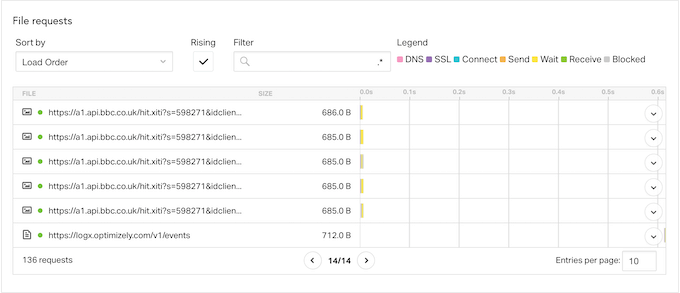
To search out the third-party requests, merely search for any objects that don’t start along with your web site’s area title.
If you wish to be taught extra a couple of request, then merely hover your mouse over its bar within the waterfall chart.
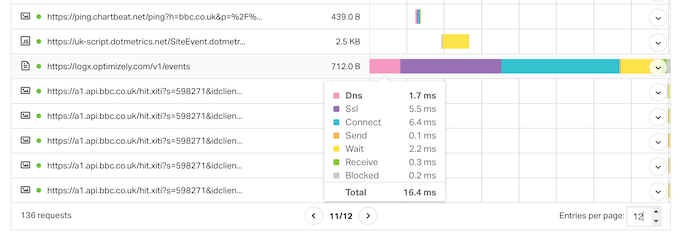
Right here, you’ll see all of the steps that WordPress takes to get content material from this third-party area together with making a DNS lookup, SSL handshake, and downloading information from that area.
Pingdom additionally reveals how lengthy every step takes, so you may establish the area requests that make the largest affect in your web site’s efficiency.
For those who don’t acknowledge a third-party service, then simply paste its URL right into a search engine corresponding to Google. Usually, this may deliver up hyperlinks to documentation, pages, and boards the place you may be taught extra in regards to the area.
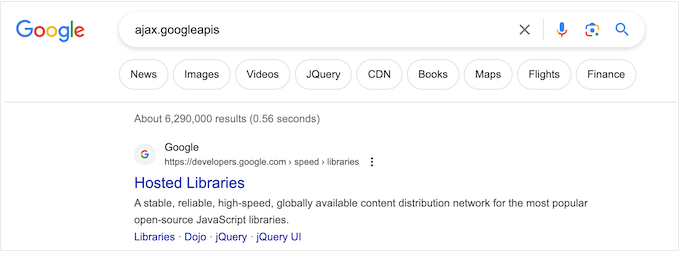
Learn how to Optimize Third-Social gathering Area Requests
When you’ve recognized the third-party area requests which can be hurting your web site’s efficiency, there are a couple of other ways to optimize these requests and enhance your WordPress velocity.
The tactic that works greatest for you could fluctuate relying on how your WordPress web site is about up, the requests it makes, and different elements. With that in thoughts, merely use the fast hyperlinks beneath to leap straight to the tactic you need to be taught extra about.
Methodology 1. Take away the Third-Social gathering Area Request
This isn’t possibility for all WordPress blogs, however eradicating a number of third-party requests can have a huge effect in your web page loading instances.
You’ll have added a website request by chance, otherwise you may need modified path so a selected third-party request now not works properly for your online business.
For instance, you could have initially added Google AdSense however now earn more money promoting WooCommerce merchandise in your on-line retailer. By eradicating Google AdSense, you may enhance your retailer’s efficiency to some extent the place you get heaps extra gross sales, and make far more cash in comparison with exhibiting on-line adverts.
Right here, there’s no simple resolution that can work for all web sites. With that in thoughts, you could need to attempt eradicating totally different companies and content material out of your web site, after which monitoring the affect this has on essential metrics corresponding to your conversion charges.
For those who do resolve to take away function and plugins that make third-party area requests, then it’s sensible to again up your WordPress web site. This lets you rapidly restore your web site for those who encounter any errors, or just understand you made a mistake.
You may additionally need to put your web site into upkeep mode whereas making this transformation, simply in case it breaks your web site.
The steps for eradicating third-party area requests will fluctuate relying on the request.
Nevertheless, you may usually discover detailed step-by-step guides within the documentation for the associated service, plugin, or software program, or by typing your search question into Google. For extra on this matter, please see our information on methods to correctly ask for WordPress assist and get it.
Methodology 2. Take away Pointless WordPress Plugins
Plugins are an enormous motive why WordPress is so fashionable. With the appropriate plugins, you may add lacking options, prolong the built-in performance, and switch your WordPress weblog into any type of web site.
Nevertheless, some WordPress plugins make loads of third-party requests and should even decelerate your web site. You is likely to be utterly unaware that these requests are even taking place.
With that in thoughts, it’s a good suggestion to go to Plugins » Put in Plugins within the WordPress dashboard, and take away any plugins that you just now not want.

You’ll be able to even attempt changing a number of smaller plugins with a single WordPress plugin. For instance, there are numerous website positioning plugins and instruments available on the market, however AIOSEO is an entire website positioning toolkit that performs an extended listing of essential website positioning duties.
Methodology 3. Preconnect to Essential Third-Social gathering Domains
Another choice is to connect with the exterior area proper firstly of the web page loading course of. When a browser preconnects to an exterior area first, it could actually usually obtain the third-party content material a lot quicker.
Simply bear in mind that preconnecting to an exterior URL takes assets away from loading the remainder of your web page. If the exterior useful resource isn’t essential, then prioritizing it on this method might harm the person expertise by delaying the remainder of your content material.
To make use of the preconnect technique, you’ll want a listing of all of your third-party area requests. For those who haven’t already, then you will get this data utilizing Pingdom, and by following the method described above.
After that, you’ll want so as to add customized code in WordPress. Some guides will let you know to edit your theme recordsdata straight, however this will trigger many frequent WordPress errors. You additionally gained’t have the ability to replace your WordPress theme with out dropping customization.
That’s why suggest WPCode.
WPCode is the most effective code snippets plugin that permits you to add customized CSS, PHP, HTML, and extra with out placing your web site in danger. You may as well allow and disable your code snippets with the press of a button.
First, you’ll need to put in and activate the free WPCode plugin. For extra data, see our step-by-step information on methods to set up a WordPress plugin.
As soon as the plugin is activated, go to Code Snippets » Add Snippet.
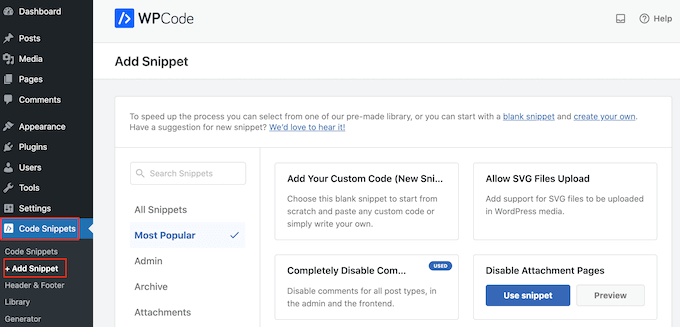
Right here, you will notice all of the ready-made WPCode snippets you may add to your web site. These embrace a snippet that permits you to utterly disable feedback, add file sorts that WordPress doesn’t normally assist, disable attachment pages, and rather more.
Merely hover your mouse over the ‘Add Your Customized Code (New Snippet)’ possibility and click on the ‘Use snippet’ button when it seems.
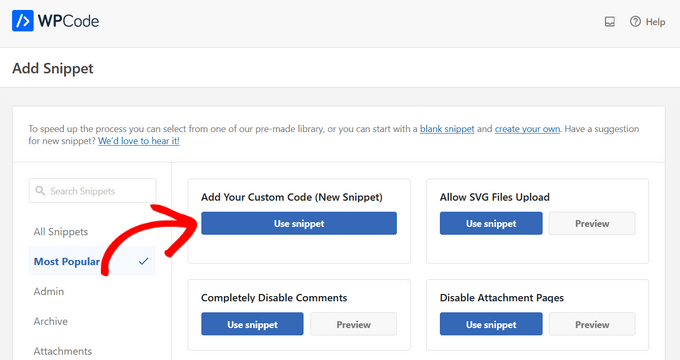
On the following display, it’s worthwhile to sort in a title for the code snippet. That is simply to your reference, so you should use something you need.
Then, open the ‘Code Sort’ dropdown and select ‘JavaScript Snippet.’
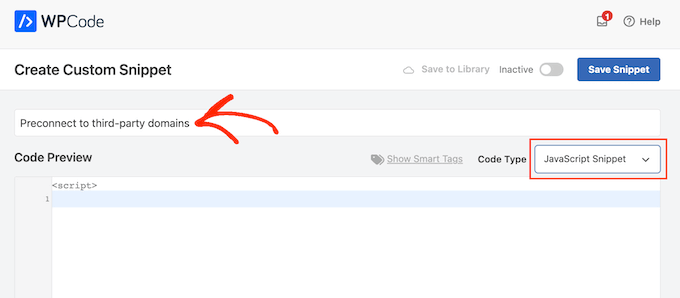
With that carried out, you’re prepared so as to add every area that WordPress ought to preconnect to.
For instance, within the following code snippet we’re preconnecting to Google Fonts.
Within the code editor, merely add every exterior URL that you just need to use.
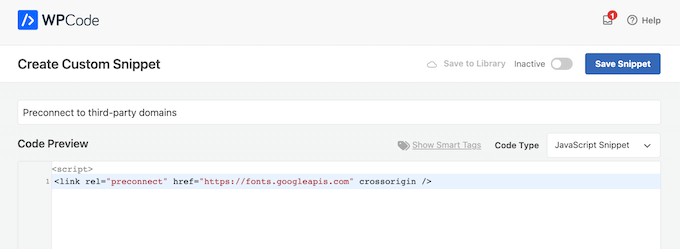
With that carried out, go forward and scroll to the ‘Insertion’ settings. Right here, choose ‘Auto Insert’ if it isn’t already chosen.
You’ll be able to then open the ‘Location’ dropdown and select ‘Web site Huge Header.’

Once you’re able to make the code snippet stay, scroll to the highest of the web page and click on on the ‘Inactive’ toggle so it adjustments to ‘Energetic.
Then, click on on the ‘Save Snippet’ button.
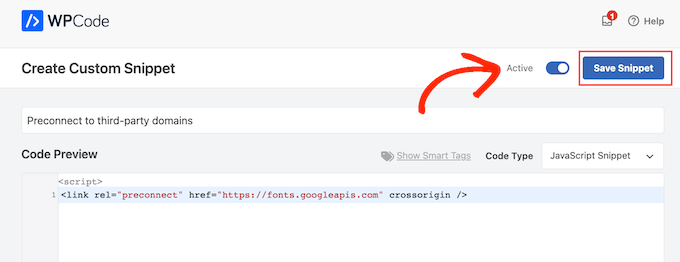
Methodology 4. Implement DNS Prefetching
DNS prefetching permits you to carry out a DNS lookup within the background earlier than the customer wants the linked content material or useful resource. That is notably helpful for third-party assets which can be used throughout your web site, corresponding to Google Analytics, Google Fonts, or your WordPress Content material Supply Community (CDN) service.
To make use of DNS prefetching, merely create a brand new JavaScript snippet utilizing WPCode, and by following the identical course of described above.
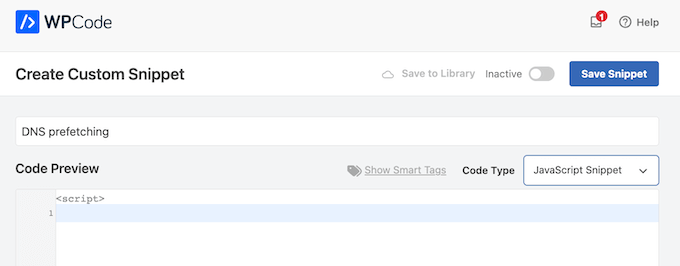
With that carried out, add every area title that you just need to prefetch utilizing the next format:
After coming into this data, add the code to your site-wide header by following the steps described in Methodology 3, after which publish the code snippet.
Methodology 5. Host Sources Domestically
When used accurately, preconnecting and prefetching can help you make third-party area requests with out impacting the customer expertise. Nevertheless, the place ever attainable it’s best to attempt to host assets and content material regionally.
Retrieving content material from a neighborhood server is usually a lot quicker, and it’s simpler to enhance that content material’s efficiency. For instance, you may use a caching plugin, or arrange a CDN.
There are many totally different WordPress plugins and companies that may assist you to host content material regionally. For instance, if you wish to use customized typography then you may host native fonts in WordPress slightly than loading them from a third-party corresponding to Google Fonts.
Equally, you may simply add distinctive icon fonts to your WordPress theme utilizing a plugin corresponding to SeedProd.
For those who’re utilizing Google Adverts, Google Analytics, Marketing campaign Supervisor, or different fashionable free Google merchandise, then you may host the gtag.js script regionally by yourself server utilizing MonsterInsights with the Efficiency Addon.
By changing exterior area requests with native assets, you may usually enhance your web site’s efficiency with out compromising on its options and content material.
Methodology 6. Use Lazy Loading
As a substitute of loading all of your content material without delay, lazy loading downloads solely the content material seen on the person’s display. It’ll then load extra content material because the person scrolls down the display. This will make it seem to be the web page is loading quicker.
WordPress will lazy load pictures by default, however relying on their location it might assist to lazy load externally hosted content material too. For instance, if you wish to embed YouTube movies in WordPress weblog posts, then you may select a plugin that has lazy loading built-in.
Different plugins corresponding to Smash Balloon YouTube Feed include built-in caching and delayed loading for the video participant. This will enhance the perceived web page load instances, even if you’re exhibiting content material from third-party web sites.
We hope this text helped you discover ways to monitor third-party area requests in WordPress. You may additionally need to take a look at our information on methods to create a customized Instagram picture feed, or see our knowledgeable decide of the most effective YouTube video gallery plugins for WordPress.
For those who favored this text, then please subscribe to our YouTube Channel for WordPress video tutorials. You may as well discover us on Twitter and Fb.




